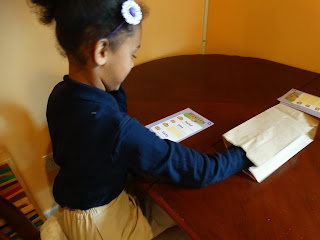Finally some new math materials for Bubs!!
Bubs was very excited to have new math materials. He had been working with the snake game for awhile and stopped pulling out the ten/teen boards awhile ago. He goes through phases of working with the paper decanomial and the bank game.
We started with the addition strip board. This board has a row of numbers 1 through 18 across the top. The numbers 1-10 are red and the numbers 11-18 are blue. There are also 9 red bars and 9 blue bars. The smallest rod is labeled with a 1 and the longest is labeled with a 9 with the remaining numbers in between.
I have a few containers with simple equations. For example, in the picture above, he has the equation 9 + 4. He takes the 9 red bar and the 4 blue bar. They are placed side by side horizontally. Then he looks at the numbers at the top to see what number he has formed. Both bars together end at 13. He then knows the answer is 13.
Here is a closer look. He did this work until he finished the container and moved on to the next one. He thought it was pretty easy which was what I was afraid of. He has passed this material, but it is a good stepping stone for his addition work.
I quickly started him on the first finger chart. He was pretty excited to have his own clipboard, special paper, and a pencil for this work. This chart is officially called the Table of Arithmetic, but we definitely wouldn't want to tell Bubs that! It might overwhelm him.
The setup of the board is red numbers from 1 to 9 vertically down the side with blue numbers 0-9 horizontally across the top. All of the other squares are the sum of one red number and one blue number. The child uses his fingers to find the answer. For example, the equation above is 3+5. Bubs puts his left finger on the red 3 and his right finger on the blue 5. Then he slides his left finger across and his right finger down until they meet in the middle at 8, which is his answer. Before he finds his answer, he writes his equation on his paper. Then he fills in the answer once he finds it. (The paper is just a simple graph paper with large squares. You can download it for free here.)
I did discover that this work is not necessarily full proof. I noticed that on one equation, he slid one finger down to the other row as he was sliding, which then made his answer incorrect. I just used that as a point of interest for the next equation. He will continue to work through all of the equations before we move on to the next finger chart for addition. Right now, I have every equation from 1+1 through 9+9. He was very excited when he got 9+9 because he was able to use the highest number on the board. If you click on the pic, you can see his equations written on his paper. Sorry I didn't take a better pic of that.



















